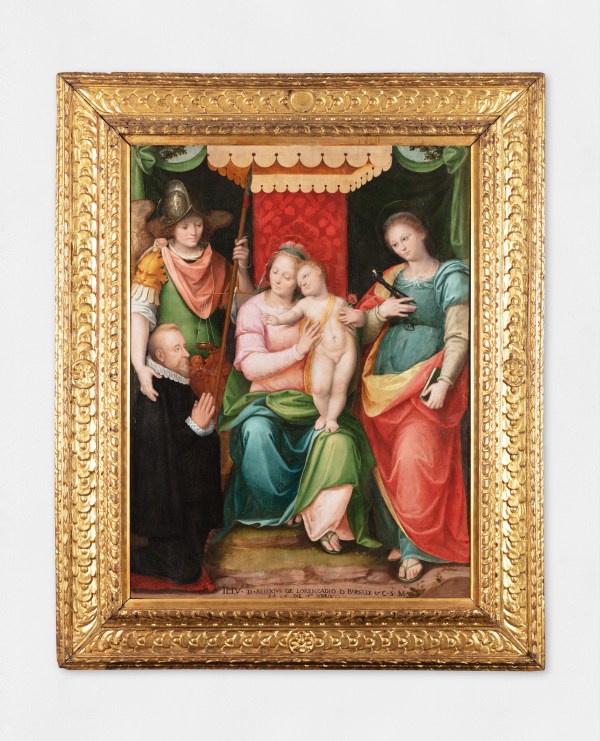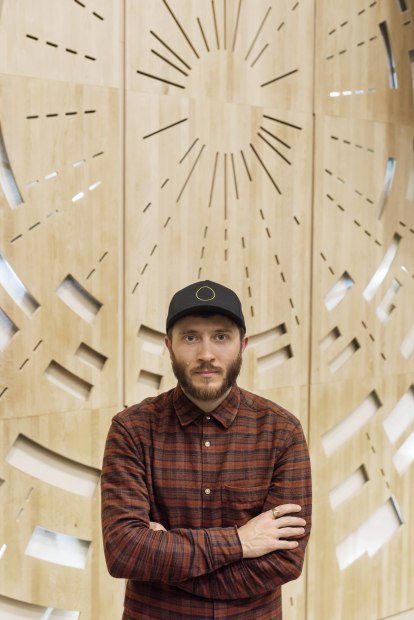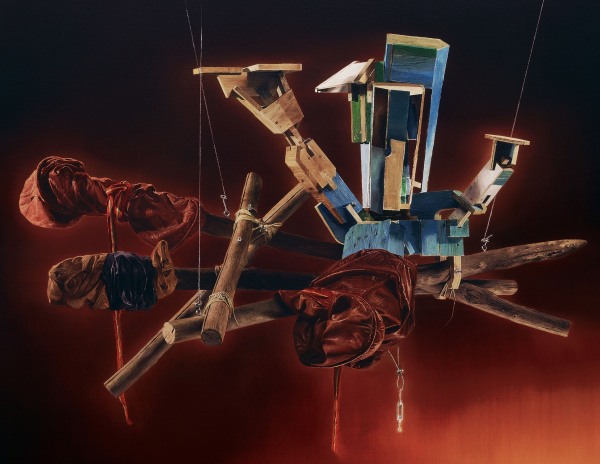< Meta-Links >: Online Exhibition curated by Luca Pozzi, Artist and Cross-Disciplinary Mediator, Winner of the VDA Award (Var Digital Art 2023).
-
<Meta-Links is an experiment to observe how the information surrounding us is part of a delicate interconnected ecosystem.>
-
-
An exhibition that connects people, jumping into the universe of art with irregular intermittence looking for non-linear hyperlinks and far away correlations that could bring together what seems to be distant in space and time.The artworks of 12 Cross-Generational Artists that – eachtellingtheir own story – land on the UniCredit Art Collection website in the shape of Meta-Links, that is to say, Hyperlinks hidden in the HTML code of the Internet.The result is the emergence of a hybrid digital-analogue dimension where the most recent experiments of post-modern derivation – including those of Jeppe Hein, Grazia Toderi, Rosa Barba and Hans Op de Beeck – connect to the beginnings of the Giotto di Bondone’s school of modern painting and the Renaissance humanist revolution, passing through the 20th-century masterpieces of Giorgio De Chirico and Giacomo Balla.
< In a suspended present where artificial intelligence, metaverses and augmented reality blur the boundaries of authorship, presence and identity, artworks whisper that there is a middle way to go through while forgetting one's name. >
-
-
-
<360° Illusion II.> is part of a series of works by Jeppe Hein, a Berlin-based Danish artist born in Copenhagen in 1974. The artwork is dedicated to questioning the perception of space and time – as they are usually known – by holding up two orthogonal mirror surfaces constantly moving. They reflect and multiply the spectator’s point of view and their architectural coordinates, creating a particular sense of disorientation, fragmentation and reconnection at a distance. His research – inspired by the minimalist traditions and conceptual art of the 1970s – is nourished by suggestions from both the scientific world of quantum mechanics and Eastern Buddhist meditative practices. </360° Illusion II.><VB54.19nt, JFK Airport,> New York is a work made in 2004 by the Italian-British artist Vanessa Beecroft, based on her homonymous performance. Born in Genoa in 1969, she was one of the leading international exponents of the 1990s art and has distinguished herself through a series of performances held in places steeped in history and geopolitics. She is the author of an unprecedented cross-over research that merged the fashion and glamour imagery of the world-famous Italian fashion industry with the ancient practice of Tableau Vivant – derived from medieval liturgy, Renaissance theatre and Baroque court. In her work VB54, 35 semi-naked models painted in black are at New York's JFK airport. Their bodies are suspended in a kind of limbo as if they were waiting for something or were “lost in translation” – as the movie director Sofia Coppola would say. Lost in “transition”, caught in the embarrassment and urgency of defining their own identity, their uniqueness goes beyond the Western stereotypes of beauty and homologation, derived from the most unbridled globalisation. Their bodies travel while remaining almost steady, simply because they do not move in space but across the Art language between reality and representation. </VB54.19nt, JFK Airport, New York.>The <Madonna in Maestà o Madonna col Bambino> altarpiece realised between 1295 and 1310 by the Giotto di Bondone’s school represents the harmonic balance between religious symbolism, scientific naturalism and emotional realism. This was inspired by a new philosophy centerd around the ecosystem and introduced by St Francis. Giotto depicted the life, death and miracles of the Saint during roughly the same years – between 1292 and 1296 – in the Upper Basilica of Assisi. This work seeks and finds a fluid continuity between three-dimensional space and two-dimensional pictorial representation almost a hundred years before the birth of the geometric and mathematical perspective. It can be considered the medieval equivalent of Space X's Starship, as the Gothic pointed arch recalls its shape. A true technological device created with painting tools to explore the universe, going beyond the illusory dimensional barriers. </Madonna in Maestà o Madonna col Bambino>
-

Rendez-Vous
Grazia Toderi, 2005
Grazia Toderi <Rendez-Vous>.The artist was only two years old when, in 1965, two NASA probes – Gemini 6 and 7 – met in space after the longest journey so far undertaken by two US crews in preparation for the memorable moon landing of 1969. A very unlikely encounter, which was nevertheless made possible thanks to the almost miraculous coordination of a team of scientists who managed to avert all potential failure variables.
The artwork – based on her 2005 video installation – broadens the encounter between the two probes to a third actor. By teleporting them inside Turin's Venaria Reale in the Baroque church of Sant’Umberto dello Juvarra, it interconnects distant spaces and times, alternates the force of gravity and brings up an alternative physics to the dominant everyday experience. </Rendez-Vous>
-
-
The universe is made of webs of kisses, not stones.
Quote by Carlo Rovelli (Theoretical Physicist)
-
< What links a space probe to an 18th-century church? A knight to his castle? Rotten watermelons to rusty armour? Pointed sticks held together by strips of padded fabric to fragile scaffolding suspended by thin steel cables? >
Several premises underlie Giorgio de Chirico’s and his brother Alberto Savinio’s Metaphysics. They were known as the Greek Dioscuri of the 20th century and believed what is underlined in Savinio’s words: "The more intelligent the artist, the more he uses indirect means". The <Ritorno al Castello Avito> and <Cocomeri e Corazze> are explicit proof of this. In these artworks, as well as in their metaphysical painting, art is considered an exploratory mission, an attempt to go beyond one's physical and cognitive limits. In addition, language is intended as "Argo" or the great Argonaut's navigation vehicle – capable of jumping between dimensions, reality and fiction, life and legend – looking for the Golden Fleece of Chrysomallo that defeats all illnesses and grants eternal life. These are the premises that underlie their works of art. </Ritorno al Castello Avito> </Cocomeri e Corazze>
The same metaphysics is echoed in the <Senza Titolo> work by Pierpaolo Campanini (Ferrara, 1964). His own words even confirm it: “Painting is just a desire for me. It is not the first thing I did...It took time, it brought a certain chaos to my organised thoughts. Through disorder, details that were buried in memory slowly emerged, along with topics left out in forgotten conversations, things seen from the corner of my eye.” </Senza Titolo>
-
-
-
-
The film <Outwardly from Earth's Centre> by Rosa Barba was exhibited at the Centre Pompidou in Metz in 2016 and at Columbia University in New York in 2017. As the artist says: "It is based on the story of a fictitious society that lives in an unstable piece of land at risk of disappearing. A circumstance that demands collective action from the population to ensure the survival of both individuals and society. The imaginary setting is inspired by Gotska Sandön, a Swedish island in the north of Gotland in the Baltic Sea which moves about one metre per year. Moreover, fake reports by experts draw a surrealist picture of what is happening. The experience of what at first glance might seem like a beautiful documentary develops into a more abstract and slightly absurd picture of the inhabitants' struggles and vulnerability." </Outwardly from Earth's Center>
Realised on the occasion of a major exhibition for MAXXI in Rome in 2009, Hans Op De Beeck's <In Silent Conversation with Correggio – Nocturnal Sea> is a large watercolour on paper of 134.4 x 244.7cm. It was inspired by the work of Correggio, a Renaissance artist who ideally broke through the dome of Parma Cathedral in 1524, and perhaps reached the peak of perspective wisdom in painting. In his 2009 artwork, Hans Op De Beeck recalls the humanist wave that exploded in Europe in the past, reconstructing its distant echoes and taking them back to his Flemish culture of origin. Born in Turnhout in northern Belgium in 1969, he reaps the benefits of perspective on the shores of a cold but soft, silent but imposing, Nordic sea. There, the threshold between sky and sea, waves and clouds, and geopolitical boundaries is a thin line disappearing over the horizon. </In Silent Conversation with Correggio – Nocturnal Sea>
A horizon that we find again, albeit ideally, in Nedko Solakov's work. <The Passage (a commissioned artwork's story)> realised by the Bulgarian artist (Cherven Bryag, 1957) interpolates the simultaneity of two apparently disconnected fortuitous events. The death of his father and the meeting with two masters of art history during the exhibition Caravaggio and Bacon at the Galleria Borghese in Rome, between October 2nd 2009 and January 24th 2010. The artwork is made of two paintings installed four metres apart from each other and on two painter's easels connected by a series of floating writings created by Solakov in blue pen on a white wall. It is a bridge between life and death, between the past of memories and the future that awaits us. </The Passage (a commissioned art work's story)>
-
-
Lorenzo Costa was Mantegna's successor at the court of the Gonzaga family in Mantua. In 1520 he created the wooden altarpiece of < St. Anthony of Padua and Saint Catherine and Saint Ursula > as an ethical, artistic and philosophical statement. Each character of the painting is like an ingredient. From St. Anthony of Padua he takes a pinch of purity and two handfuls of rectitude and humility, which are conveyed especially through the illustration of the Franciscan habit and the sacred scriptures from which the white lily sprouts; from St Ursula he takes 300 grams of coherence and 100 of fidelity to the Christian crusade – whose banner she protects; from St. Catherine he takes a drop of communion with the divine, her being the vessel of the trinity of father, son and holy spirit united in one body – a body which, in Costa’s interpretation represents the painting itself. </S.Antonio da Padova e le Sante Caterina e Orsola>
Gerolamo Lanino instead, brings us into the presence of Saint Michael the Archangel with a late Renaissance work. The Archangel, together with Saint Apollonia and a devout knight, pays homage to the Madonna with her Child. In his work, Saint Michael corresponds to the one “who must bind the false prophet into the flaming pond”, Saint Apollonia is the one “who prefers death to blasphemy”, while the Devoted Night is any observer – meaning us – capable of distinguishing true beauty from false illusions. </ Madonna col Bambino, san Michele Arcangelo, Sant'Apollonia e un devoto cavaliere>
<These are all meta-narrative elements linked within the work originating from parallel social, political, economic, religious and cultural times and worlds>
Giacomo Balla was one of the greatest exponents of the Futurist movement, which developed between the two World Wars. In these terms, even his research can be read as a free and dynamic manipulation of “history” in a meta-narrative way. A history that can be considered not as something absolute and static to be described, but more like a process that constantly redefines events. Events that – as Gilles Deleuze and Felix Guattari theorised in their famous 1980 book “Mille Piani” – can be reconnected according to a rhizomatic logic, generating new creative freedom.
This creative freedom emerged already in 1915 in the “Futurist Reconstruction of the Universe” manifesto written together with De Pero, when Balla stated the following: "We, Futurists, want to realise this total fusion to reconstruct the universe by cheering it up, that is, by recreating it in its entirety."
And then it re-emerges today in 2024, on the threshold of a third war of planetary proportions, in an exhibition curated by a cross-disciplinary artist and mediator that ironically closes with the 1916 work <La Guerra>, but re-proposed in an explicit pacifist key. </ La Guerra>
-
-
</Meta-Links >
Artists:
Giacomo Balla, Rosa Barba, Vanessa Beecroft, Hans Op de Beeck, Giotto di Bondone, Pierpaolo Campanini, Giorgio De Chirico, Lorenzo Costa, Jeppe Hein, Gerolamo Lanino, Nedko Solakov, Grazia Toderi.
-

-
Works
-
 Jeppe Hein, 360° Illusion II, 2007
Jeppe Hein, 360° Illusion II, 2007 -
 Vanessa Beecroft, VB54.19.nt, JFK Airport, New York, 2004, 2004
Vanessa Beecroft, VB54.19.nt, JFK Airport, New York, 2004, 2004 -
 Giotto di Bondone (collaborator), Madonna in Maestà o Madonna col Bambino, c.1295-1310
Giotto di Bondone (collaborator), Madonna in Maestà o Madonna col Bambino, c.1295-1310 -
 Grazia Toderi, Rendez-Vous, 2005
Grazia Toderi, Rendez-Vous, 2005 -
 Giorgio de Chirico, Ritorno al castello avito, 1970
Giorgio de Chirico, Ritorno al castello avito, 1970 -
 Giorgio de Chirico, Corazze e cocomeri, 1924
Giorgio de Chirico, Corazze e cocomeri, 1924 -
 Pierpaolo Campanini, Untitled, 2008
Pierpaolo Campanini, Untitled, 2008 -
 Rosa Barba, Outwardly From Earth´s Center, 2007
Rosa Barba, Outwardly From Earth´s Center, 2007 -
 Hans Op de Beeck, In Silent Conversation with Correggio - Nocturnal Sea, 2009
Hans Op de Beeck, In Silent Conversation with Correggio - Nocturnal Sea, 2009 -
 Nedko Solakov, The Passage (a commissioned art work's story), 2010
Nedko Solakov, The Passage (a commissioned art work's story), 2010 -
![An oil painting of Saint Catherine, Anthony of Padua and Ursula, set in a natural landscape. Saint Catherine is seen on the left dressed in pink, blue and orange. At her feet, a broken spiked wheel and sword. The wheel is the instrument of torture that Catherine was condemned to death on by the Roman Emperor Maxentius [306-312] for her strong Christian beliefs. According to legend, the wheel broke when she touched it, so she was beheaded with the sword. In the Centre, Saint Anthony of Padua, dressed in a monk's robe, is holding a white lily and an open book. According to legend, the book represents an event when Anthony had a psalter (a book of psalms) stolen in Bologna, which is the origin of calling upon St. Anthony when something is lost or stolen. The lily represents purity and his battle against the devil. Saint Ursula, on the right, is dressed in red, blue and white, holding a flag and a single arrow. The legendary Romano-British Christian saint is said to have died along with an anonymous group of holy virgins in Cologne. Saint Ursula was fatally shot with an arrow during a pan-European pilgrimage by the leader of the Huns', a nomadic people who lived in Central Asia who had besieged Cologne. Artwork details: Artist: Lorenzo Costa. Artwork title: S. Antonio da Padova e le Sante Caterina e Orsola. Artwork year: c.1500-25. Artwork medium: Oil on board. Artwork dimensions: 217 x 175.5 x 2.5 cm.](data:image/gif;base64,R0lGODlhAQABAIAAAAAAAP///yH5BAEAAAAALAAAAAABAAEAAAIBRAA7) Lorenzo Costa, S. Antonio da Padova e le Sante Caterina e Orsola, c.1520
Lorenzo Costa, S. Antonio da Padova e le Sante Caterina e Orsola, c.1520 -
 Gerolamo Lanino, Madonna col Bambino, san Michele Arcangelo, sant'Apollonia e un devoto cavaliere, 1585
Gerolamo Lanino, Madonna col Bambino, san Michele Arcangelo, sant'Apollonia e un devoto cavaliere, 1585 -
 Giacomo Balla, La Guerra, 1916
Giacomo Balla, La Guerra, 1916
-




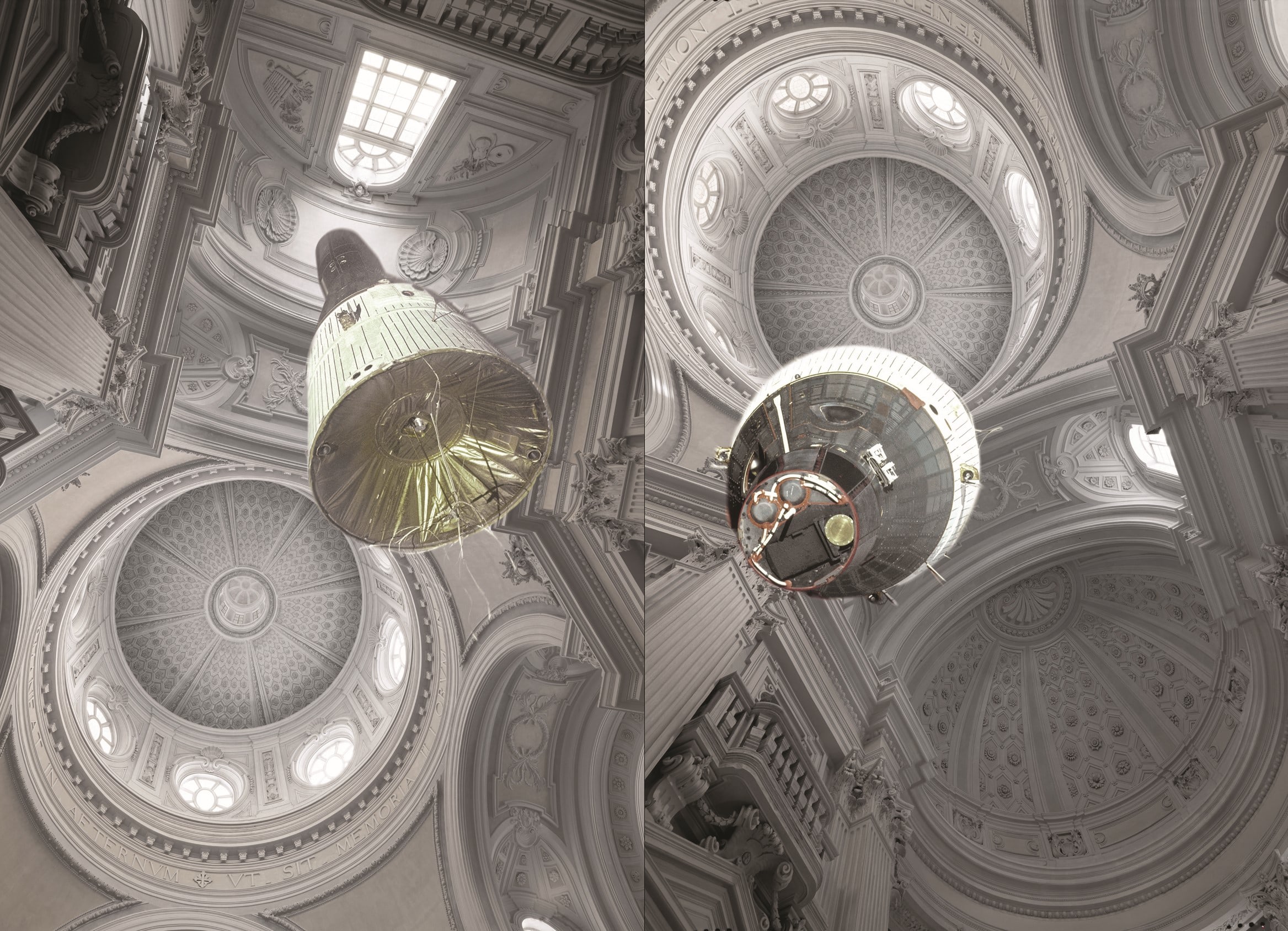
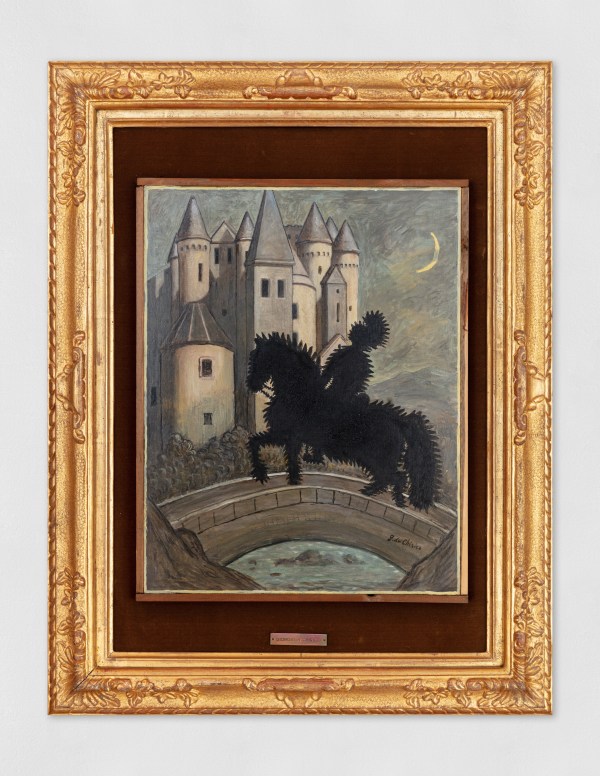


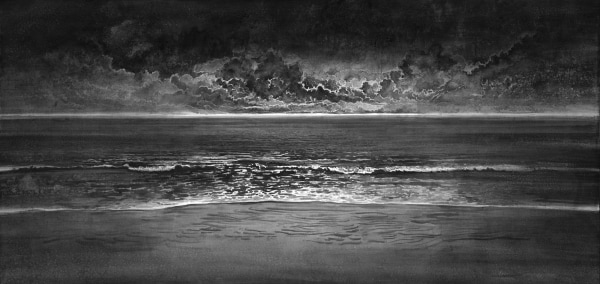

![An oil painting of Saint Catherine, Anthony of Padua and Ursula, set in a natural landscape. Saint Catherine is seen on the left dressed in pink, blue and orange. At her feet, a broken spiked wheel and sword. The wheel is the instrument of torture that Catherine was condemned to death on by the Roman Emperor Maxentius [306-312] for her strong Christian beliefs. According to legend, the wheel broke when she touched it, so she was beheaded with the sword. In the Centre, Saint Anthony of Padua, dressed in a monk's robe, is holding a white lily and an open book. According to legend, the book represents an event when Anthony had a psalter (a book of psalms) stolen in Bologna, which is the origin of calling upon St. Anthony when something is lost or stolen. The lily represents purity and his battle against the devil. Saint Ursula, on the right, is dressed in red, blue and white, holding a flag and a single arrow. The legendary Romano-British Christian saint is said to have died along with an anonymous group of holy virgins in Cologne. Saint Ursula was fatally shot with an arrow during a pan-European pilgrimage by the leader of the Huns', a nomadic people who lived in Central Asia who had besieged Cologne. Artwork details: Artist: Lorenzo Costa. Artwork title: S. Antonio da Padova e le Sante Caterina e Orsola. Artwork year: c.1500-25. Artwork medium: Oil on board. Artwork dimensions: 217 x 175.5 x 2.5 cm.](https://artlogic-res.cloudinary.com/w_600,c_limit,f_auto,fl_lossy/artlogicstorage/unicredit/images/view/0c15ae9dbec69ef1cb614c876caf1fdbj/unicreditartcollection-lorenzo-costa-s.-antonio-da-padova-e-le-sante-caterina-e-orsola-c.1520.jpg)
